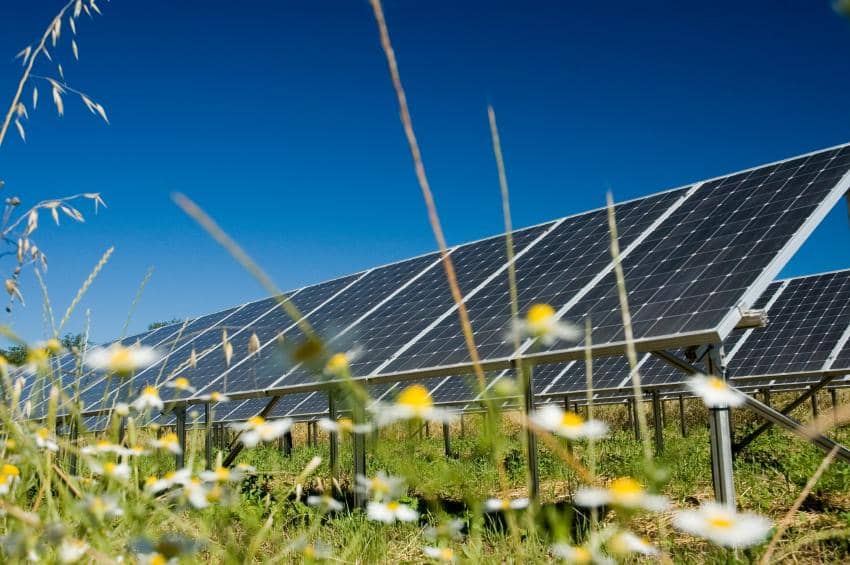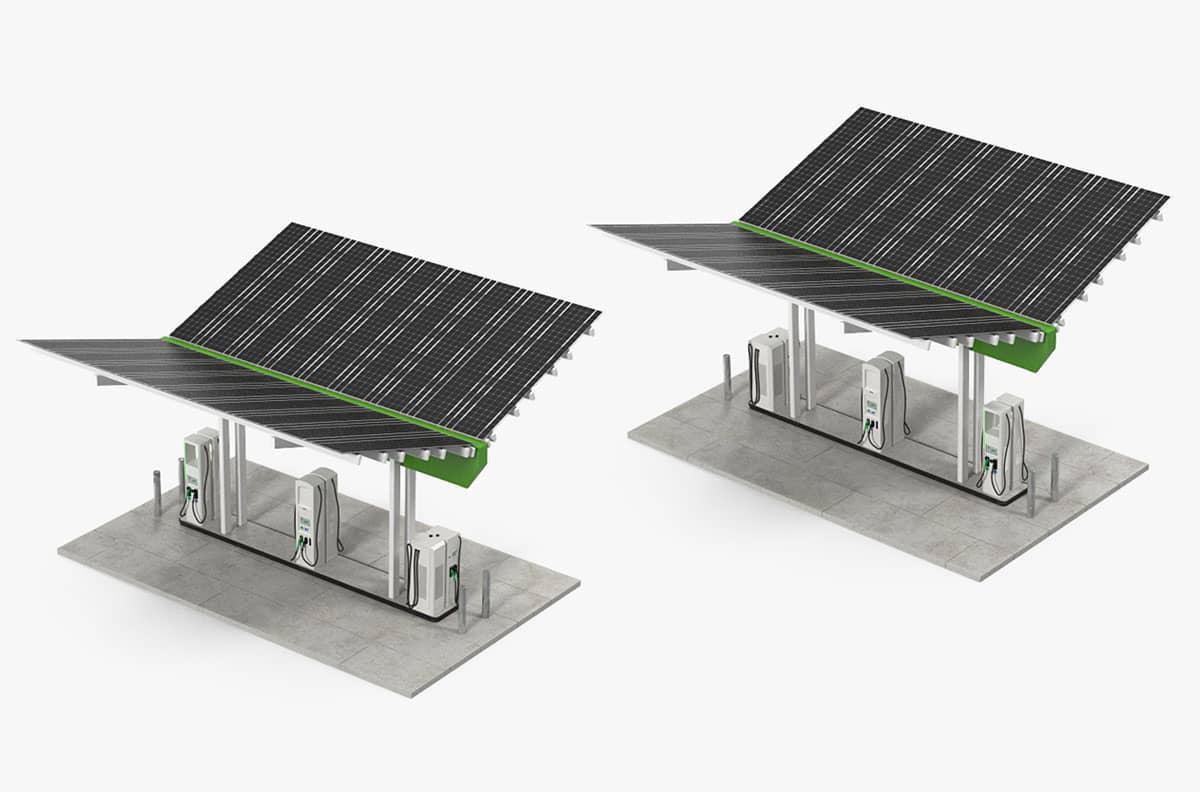Solar power is a sustainable and cost-effective source of electricity. Here are answers to questions frequently asked by EV owners about solar EV charging:
Solar charging stations work by converting sunlight into direct current (DC) electricity using solar panels.
Here’s how it works:
An inverter converts the DC electricity generated by the solar panels into alternating current (AC) electricity.
The AC electricity is then sent to a distribution board to be used by power devices, and any excess electricity is stored in a battery or fed back to the grid for others to use.
A smart EV charger uses the solar-generated AC electricity to charge your EV directly from the distribution board or battery, using 100% solar power or a combination of solar and grid power to achieve the desired charging speeds.
Your EV’s onboard charger then converts the AC power back into DC electricity.
Solar charging stations are a sustainable and cost-effective way to charge EVs. Make sure to consult with a qualified technician to ensure the safety and proper functionality of your solar charging station.
A solar EV charging station offers more than just sustainability and cost savings. Here are six primary benefits:
1.Energy Costs: Solar-generated electricity is cheaper than grid electricity, and can reduce monthly power bills by up to 50%.
2.Net Metering: Excess solar-generated electricity can be pushed to the grid for credit or sold to the utility provider at a profit.
3.Zero Carbon Footprint: Solar EV charging stations guarantee a 100% carbon-neutral footprint, compared to grid electricity which is often manufactured from non-renewable energy.
4.Convenience: Public charging stations can be inconvenient, but home-based solar charging stations offer the ultimate convenience and insurance against grid outages.
5.Tax Credits and Incentives: There are Federal, State, and Local tax credits and incentives for EVs, EV charging, and solar EV charging.
6.Increased Property Value: Homes with solar systems sell more quickly and at a higher price than those without them, according to studies.
Charging your EV with solar panels requires a solar panel system designed for EV charging. Here’s what a typical setup includes:

Solar panels mounted on your roof in metal racks
A central string inverter or micro-inverters that convert DC output to AC and send it to a combiner box
A Level 2 EV charger
Here are some vendors that specialize in installing home solar systems for EV charging:
Freedom Solar (12 locations nationally)
Sunpower Solar
Sunnova (servicing all 50 states)
If you’re a DIYer, Electric City outlines a six-step process for installing a solar at-home EV charger. Keep in mind that it’s important to consult with a qualified technician to ensure the safety and proper functionality of your solar charging system.
The number of solar panels needed to charge your EV at home depends on several factors:
Your daily driving distance
The amount of sunlight your area receives daily
The wattage of your solar panels
Your EV’s fuel efficiency
For example, if you drive a Tesla Model Y for about 37 miles per day and your area receives an average of 4.5 hours of sunlight daily, you’ll need to install six 400w solar panels to provide enough power to charge your EV at home.
On the other hand, if you drive a 2014 Toyota RAV4 with a fuel efficiency of 2.17 miles per kWh and all other factors are the same as in the Tesla example, you’ll need ten 400w solar panels to charge your EV for daily use.
To calculate the number of panels needed for both home power needs and EV charging requirements, visit TheSolarNerd.com. Consult with a qualified technician to ensure the safety and proper functionality of your solar charging system.
The time it takes to charge an EV using solar panels depends on various factors, including:
Solar panel wattage
Type of solar panel controller
Battery AMPs
Battery discharge depth
For example, charging a 12V 50Ah lithium battery that’s 80% discharged using a 100W solar array with an MPPT controller will require six peak sun hours to achieve a full charge. If your location receives three peak sun hours daily, you’ll need two days to charge your battery fully.
To determine the number of peak sun hours you need for your specific parameters, you can use a charging time calculator. To find the average peak sun hours received by your location, you can use a peak sun hours calculator. FootprintHero.com offers both resources to help you estimate charging times for your EV using solar panels.

(Image source: PiwinEnergy.com)
Keep in mind that charging times can vary greatly depending on the specific parameters of your solar panel system. Consult with a qualified technician to ensure the safety and proper functionality of your solar charging system.
The best time to charge an EV with solar panels depends on whether you have a time-of-use (TOU) plan with your electric utility company or a Net Metering/Net Billing plan.
For a Net Billing plan with TOU, it’s best to charge during off-peak hours if the savings are greater than the difference between your retail and wholesale rate. Otherwise, charge when your panels are producing power (while the sun’s out). For a Net Billing plan without TOU, it’s best to charge when your solar panels are producing power.
Most late-model EVs can be set to charge automatically at a specific time, making it easier for owners to target lower-cost periods. If your EV doesn’t have this feature, you can buy an EV charger with a built-in timer.
By charging your EV at the best time, you can maximize the financial return and environmental benefit of your solar panels. Consult with a qualified technician to ensure the safety and proper functionality of your solar charging system.
Portable solar panels for EV charging are small, lightweight options for EV owners who want to charge their vehicles at home without installing a permanent solar panel system. These panels are easy to install, needing little more than a connection between the panel and your EV battery.
Portable solar panels use photovoltaic cells to absorb the sun’s energy and convert it into electricity. They are a great option for those who want to charge their EVs from anywhere using renewable solar energy.
Several well-known manufacturers offer portable solar panels for EV charging, including Bluetti, EF Ecoflow, Goal Zero, Jackery, Renology, and Rockpals. Light Tower Pro provides a list of the best portable solar panels for EV chargingincludes models from these manufacturers.
Off-grid solar EV chargers are a type of charging system that stores solar-generated power in batteries. These chargers operate independently of the grid, meaning they do not require plugging into the grid.
Unlike portable solar panels, off-grid solar EV chargers are typically the size of a full-size automobile. It is accompanied by a box-like structure containing the storage batteries.
The power generated and sold by off-grid solar EV chargers is usually less expensive than power from the grid, especially during peak periods. This makes them a cost-effective and environmentally friendly option for EV owners who want to charge their vehicles using renewable solar energy.
Several companies offer off-grid solar EV chargers, including Envision Solar, FreeWire Technologies, and SparkCharge. These chargers can be installed in various locations, including homes, parking lots, and public spaces.
[INSERT_ELEMENTOR id=”4162″]